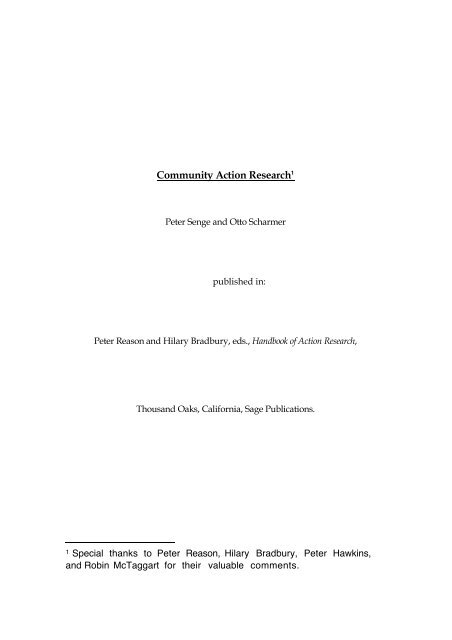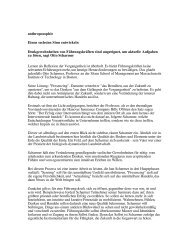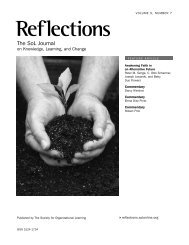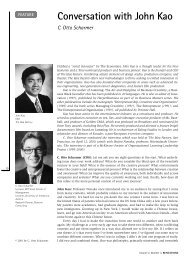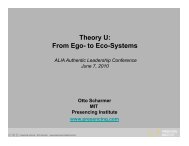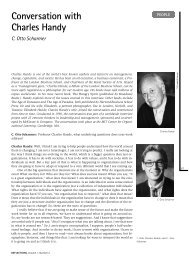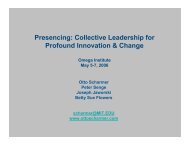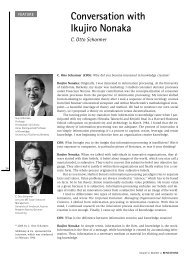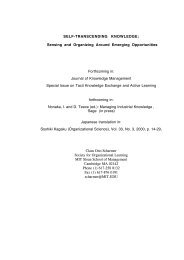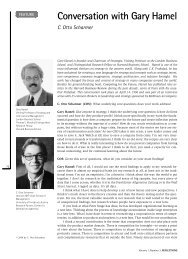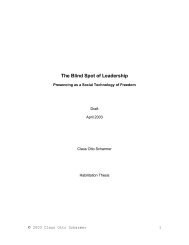Community Action Research - Otto Scharmer
Community Action Research - Otto Scharmer
Community Action Research - Otto Scharmer
Create successful ePaper yourself
Turn your PDF publications into a flip-book with our unique Google optimized e-Paper software.
<strong>Community</strong> <strong>Action</strong> <strong>Research</strong> 1<br />
Peter Senge and <strong>Otto</strong> <strong>Scharmer</strong><br />
published in:<br />
Peter Reason and Hilary Bradbury, eds., Handbook of <strong>Action</strong> <strong>Research</strong>,<br />
Thousand Oaks, California, Sage Publications.<br />
1 Special thanks to Peter Reason, Hilary Bradbury, Peter Hawkins,<br />
and Robin McTaggart for their valuable comments.
Senge and <strong>Scharmer</strong> 2<br />
This article presents an emerging approach to building knowledge for large scale<br />
transformational change. Laying behind this approach is a core premise: that<br />
Industrial Age institutions face extraordinary challenges to evolve which are<br />
unlikely to be met in isolation. Collaboration and joint knowledge building is vital.<br />
Competition, which fueled the Industrial era, must now be tempered by<br />
cooperation. Without this balance, organizations of all sorts will be unable to<br />
survive the hyper-competition of today's global marketplaces. While competition<br />
and competitiveness remain the mantra of traditional market advocates, the frenzy<br />
for optimal return on financial capital today threatens health and sustainability on<br />
all levels, not only of individual institutions but of their members and indeed the<br />
larger social and natural systems in which they are embedded.<br />
<strong>Community</strong> action research represents an approach to collaborative knowledge<br />
creation with which we have been engaged now for some ten years. <strong>Community</strong><br />
action research builds on the tradition of action research by embedding change<br />
oriented projects within a larger community of practitioners, consultants, and<br />
researchers. Like action research, community action research confronts the<br />
challenges of producing practical knowledge that is useful to people in the<br />
everyday conduct of their lives (Reason and Bradbury, Introduction). Like action<br />
research, community action research values knowing-in-action, embracing<br />
Humberto Maturana's dictum that “all knowing is doing, all doing is knowing.”<br />
But, unlike traditional action research, community action research focuses on:<br />
1. fostering relationships and collaboration among diverse organizations,<br />
and among the consultants and researchers working with them;<br />
2. creating settings for collective reflection that enable people from different<br />
organizations to “see themselves in one another;”<br />
3. leveraging progress in individual organizations through crossinstitutional<br />
links so as to sustain transformative changes that otherwise<br />
would die out.<br />
For example, Gustavsen's (Chapter 1) account of cross-institutional democratic<br />
dialogues in Sweden in order to develop “learning regions” is a good example for<br />
what we refer to as community action research. In short, community action
Senge and <strong>Scharmer</strong> 3<br />
research places as much emphasis on building cross-organizational learning<br />
communities as on undertaking action research projects.<br />
Such communities grow from common purpose, shared principles, and common<br />
understanding of the knowledge-creating process. The purpose, building<br />
knowledge for institutional and social change, defines why the community exists.<br />
Shared principles establish deep beliefs and ground rules for being a member of<br />
the community. Understanding the knowledge creating process enables everyone<br />
to see how their efforts fit within a larger system — a continuing cycle of creating<br />
theory, tools, and practical know-how — and how they inter-depend on one<br />
another.<br />
Today, this knowledge-creating system is profoundly fragmented in the fields of<br />
management and institutional change. The consequences are ivory tower<br />
university research disconnected from practical needs (Levin and Greenwood,<br />
Chapter 9), consulting projects that generate intellectually appealing change<br />
strategies that never get implemented, and “flavor of the month” management<br />
initiatives that lack any underlying theory or long-term strategic coherence and<br />
engender more cynicism than commitment within organizations. The ultimate<br />
consequence of this fragmentation is the inability of Industrial Age institutions of<br />
all sorts — corporations, schools and universities, and public and non-profit<br />
organizations — to adapt to the realities of the present day. Especially in times of<br />
deep change, sustaining adaptive institutional responses requires better theory,<br />
method and practical know-how.<br />
But bringing the theory of community action research to life involves conditions<br />
that are only just now being understood. It starts with genuine commitment on the<br />
part of a group of managerial practitioners from diverse organizations, consultants<br />
and researchers to work together. It further requires an agreed upon system of self<br />
governance and learning infrastructures that enable relationship building,<br />
collaborative projects, and sharing insights across the entire community and<br />
beyond. Lastly, it entails appreciating and encouraging emergent learning<br />
networks that arise in ways that can be neither predicted nor controlled.<br />
The aim of this paper is to present the basic ideas underlying community action<br />
research and illustrate their potential to produce both organizational impact and<br />
new knowledge. While building such communities is challenging, the alternative
Senge and <strong>Scharmer</strong> 4<br />
is continued reliance on traditional, fragmented consulting and academic research,<br />
and on episodic organizational change programs driven by top management's<br />
latest ideas. We believe this status quo will never produce the breakthroughs in<br />
theory and practice needed to reinvent Industrial Age institutions.<br />
A Brief History of One Effort at <strong>Community</strong> <strong>Action</strong> <strong>Research</strong>: From the MIT<br />
Center for Organizational Learning to SoL (The Society for Organizational<br />
Learning)<br />
In 1991, a group of large, primarily US-based corporations came together to found<br />
the MIT Center for Organizational Learning. Is it correct to abbreviate this as OLC<br />
YES THIS IS CORRECT. USE OLC i The collaborative originated from interest in<br />
applying the “five discipline” tools and principles for organizational learning<br />
(Senge 1990, Senge. et. al. 1994) and from a belief that sustaining progress with<br />
such tools required deep and extensive change, and that this was more likely with<br />
a group of organizations willing to work together, providing examples, help, and<br />
inspiration to one another (Senge 1993).<br />
During the early 1990s, the collaborative gradually grew into the beginnings of<br />
a community. This incipient community was evident in enthusiasm for early<br />
successful projects (eg., see Senge et. al. 1994 and Roth and Kleiner 1996) and<br />
for support extended to those involved in projects that ran into difficulties<br />
(e.g., Wyer and Roth 1997). For example, when managers left firms that were<br />
not prepared to sustain innovations they had initiated, they immediately began<br />
helping other consortium companies who were not so cautious.<br />
But, as the MIT OLC community grew to include about 20 member companies<br />
and many change projects within those companies, basic problems became<br />
evident (Bradbury 1999). It became increasingly awkward to be organized as a<br />
research center at MIT. As responsibility for the success of the community<br />
became more widely shared, in a sense the “center” became increasingly<br />
distributed. Ambiguous power relationships developed. Dealing with the<br />
cross-currents of a “de-centering” organization diverted increasing amounts of<br />
time away from research and initiating new projects. Revenue growth slowed<br />
and staff expansion to serve the growing community was deferred. At the<br />
same time, despite slowing growth, the overall revenue volume was several
Senge and <strong>Scharmer</strong> 5<br />
times what it had been when the Center was founded and there was pressure<br />
from the MIT administration for a larger share of the OLC revenue to go to<br />
traditional faculty research.<br />
Beginning in 1995, a design team was formed, composed of twenty five people<br />
including representatives from member companies, senior consultants and<br />
researchers, including several MIT faculty. The task was to rethink the OLC. It<br />
was clear to all that the promise of this emerging learning community was<br />
being lost amid growing complexity and confusion.<br />
A Theory of Learning Communities<br />
The OLC redesign team met for almost two years. What some had hoped<br />
would be a quick identification of solutions became instead a deep and<br />
demanding process of reflecting on who we were and why we were here. We<br />
were fortunate to be guided in this process by VISA founder Dee Hock. Dee's<br />
ideas on "chaordic organizations," radically decentralized organizations which<br />
consistently generate order out of chaos, inspired the group to imagine that<br />
there might be a viable alternative to the centralized organization structure of<br />
the OLC (Hock 1999).<br />
Eventually, we realized that where the MIT OLC had succeeded, the success<br />
arose from three sources: a talented group of people committed to linking deep<br />
change at the personal and organizational levels, employing powerful tools<br />
based in deep theory, and a common aim to better integrate research and<br />
practice. In effect, there existed a common purpose although we had never<br />
articulated it: building knowledge for organizational transformation. There<br />
also existed an implicitly shared understanding of what we meant by<br />
knowledge and knowledge creation: advancing theory, tools, and practical<br />
know-how. What we had never addressed was how best to organize to<br />
support this common aim.<br />
In the second year, a guiding image emerged which catalyzed the shift from<br />
reflecting on our past to creating our future. We began to think of the<br />
knowledge creation process metaphorically as a tree. The roots symbolize
Senge and <strong>Scharmer</strong> 6<br />
underlying theory, below the surface — yet, though invisible to many, the<br />
ultimate determinants of the health of the tree. The branches symbolize tools<br />
and methods, the means whereby theory is translated into application. The<br />
fruit of the tree is the practical know-how whose tangible benefits ultimately<br />
prove the value of the knowledge.<br />
The tree is a living system. It continually regenerates itself, creating new roots,<br />
branches, and fruit. This self-creating arises from the interdependence of the<br />
elements. Can you imagine new branches being created in a tree without<br />
roots Or fruit that arises without branches Moreover, the system as a whole<br />
nurtures itself. What happens if all the fruit is consumed and none falls to the<br />
ground Of course, there will then be no new trees.<br />
This simple metaphor of living interdependence has powerful implications for<br />
thinking about knowledge creation. In contrast to this model of living<br />
interdependence, the present managerial knowledge creating system is deeply<br />
fragmented. Academics create theory with little connection to practice.<br />
Consultants develop tools that are often unrelated to theory. Managers focus<br />
exclusively on practical know how and results. Members of the OLC redesign<br />
team observed that, in their eagerness to “eat all the fruit,” managers may<br />
actually undermine future advances in theory, method and, ultimately, new<br />
know-how and results. “The picture of the tree showed me that I had a<br />
personal responsibility for better theory, which was a completely new<br />
awareness,” says David Berdish, director of process leadership and learning<br />
for Ford's Visteon corporation.<br />
Lastly, the tree as a living system embodies a transformative process that has<br />
deep parallels with the transformative nature of genuine learning. For the tree,<br />
this transformative process is photosynthesis, whereby complex carbohydrates<br />
are produced from the “fixing” of atmospheric carbon dioxide with water and<br />
nutrients drawn up through the tree's roots. These carbohydrates are the<br />
building blocks for the tree's fruit. Just so, at the heart of all learning is a deep,<br />
transformative process that creates new awarenesses and new capabilities, the<br />
building blocks for new practical know-how. The byproducts of this<br />
transformative process are especially interesting. Carbon fixing releases
Senge and <strong>Scharmer</strong> 7<br />
oxygen, without which life as we know it would not exist. So too does genuine<br />
learning release the life and spirit that pervades an organization where people<br />
are growing.<br />
The tree's transformative process is driven by energy from the sun, just as the<br />
learning process is driven by the energy of committed people. Thus, it was<br />
natural that, when it came time to pick a name for the new organization that<br />
emerged from rethinking the MIT OLC, we chose the Society for<br />
Organizational Learning SoL, Spanish for sun.<br />
Over this two year period, the simple picture of the tree emerged as an icon for the<br />
OLC redesign team. It also became a springboard for articulating a theory of what<br />
constitutes a learning community. A learning community is a diverse group of<br />
people working together to nurture and sustain a knowledge creating system,<br />
based on valuing equally three interacting domains of activity:<br />
• research: a disciplined approach to discovery and understanding, with a<br />
commitment to share what’s learned;<br />
• capacity building: enhancing people’s awareness and capabilities,<br />
individually and collectively, to produce results they truly care about; and<br />
• practice: people working together to achieve practical outcomes.<br />
Such a community continually produces new theory and method, new tools,<br />
and new practical know-how.<br />
The following diagram shows the three domains of activity and their<br />
consequences. (the activity streams or flows are represented by the solid<br />
arrows; the rectangles represent accumulated consequences of activity streams,<br />
stocks increased or decreased by the flows arising from these activities; the<br />
lighter, curved arrows represent causal connections among and between the<br />
different domains).<br />
Insert FIGURE 1 about here
Senge and <strong>Scharmer</strong> 8<br />
The activity of research produces a flow of new theory and method, which<br />
accumulates in a stock of theory and method. But general method, the sorts of<br />
approaches taught to graduate students, differs from practical tools, tested and<br />
refined extensively in real work situations (the second set of stocks and flows in<br />
the diagram). This is typically the work of consultants who develop reliable<br />
approaches to address practical problems. Tools and methods do not just help in<br />
solving problems, they also help in developing new capabilities. Hammers are<br />
essential to carpentry but they are equally essential to creating carpenters. In the<br />
words of Buckminster Fuller (1976), "If you want to change how people think,<br />
give them a tool the use of which will lead them to think differently." So,<br />
creating and using tools is the core activity in the domain of capacity building,<br />
the ultimate result of which is new practical know-how (the third set of stocks<br />
and flows in the diagram). This is the domain of managerial practice. Because<br />
practical know-how is inseparable from the practitioners who embody that<br />
know-how, it disappears when those who embody it leave the system.<br />
“Knowledge (is) primarily tacit... deeply rooted in an individual's action and<br />
experience” (Nonaka and Takeuchi 1995, 8 ) Thus, the stock of practical knowhow<br />
must be continually replenished through new knowledge creation.<br />
In a new field, the cycle of theory creation and its extension into practical tools<br />
and ultimately into a broad base of practical know-how may take many years.<br />
If this new knowledge represents a deep shift in prevailing ways of thinking<br />
and problem solving, it may take generations. Consider, for example that the<br />
Quality Management movement begun in Japan in the 1950's and gradually<br />
spread worldwide by the1980's had its roots in theory established in the first<br />
half of the 19th century, Poisson's law of large numbers and Quetelet's<br />
binomial or “normal” curve. By the turn of the century, basic statistical theory<br />
and method were taught widely in university sciences classrooms and, by the<br />
1920's, were being applied by statistics experts to analyze variation in<br />
production lines. But, the quality management revolution really only started<br />
after World War II, when people like Deming and Juran, building on earlier<br />
work by Shewhart (1931), led the movement to translate the philosophy and<br />
method into ideas and tools like control charts that could be understood and<br />
used by non-experts. This then led to capacity building and practical knowhow<br />
and results on a significant scale. One interesting feature of this example
Senge and <strong>Scharmer</strong> 9<br />
is the critical role of consultants in developing and applying the tools that<br />
bridged theory and practice through capacity building -- Deming's personal<br />
letterhead said, simply, “consultant in statistics,” and he frequently credited<br />
other consultants and managerial practitioners with crucial ideas and practical<br />
insights in his writings (e.g., Deming 1982). ii<br />
But, why does the knowledge creating cycle take so long Can it be<br />
accelerated To address such questions we need to understand how this<br />
knowledge creating system becomes fragmented. This arises through<br />
breakdowns in each of the major linkages that interconnect the three domains.<br />
Sources of these breakdowns can be found in the taken-for-granted attitudes<br />
and activities of each of the respective professional communities. In effect,<br />
while incomplete learning cycles within organizations usually can be traced to<br />
cognitive or structural causes (March and Olsen 1975, Kim 1993), differing<br />
cultures and institutional norms create additional sources of fragmentation for<br />
the larger knowledge creating process. In short, the worlds of academia,<br />
professional consulting firms, and managerial practitioners in both business<br />
and non-profit organizations differ in ways that make greater integration<br />
extremely difficult.<br />
For example, the development of new theory and method is isolated from the<br />
larger system through breakdowns in both "outputs" and "inputs." In<br />
particular, assessment of most academic research is dominated by peer review.<br />
While peer review is a valid source of outside critique of new theory or<br />
analysis, it rarely considers the practical consequences of research. As a result,<br />
the outputs of most academic research, journal articles, have little impact<br />
outside self-defined academic communities. Although the array of journals<br />
continues to expand, this is driven by the growing number of academic<br />
researchers to needing to publish, and most are readable only by the initiated.<br />
The fundamental problem with this entire publication-review-promotion<br />
system is that it is self-referential. The academic paper mill tends to produce a<br />
growing number of papers in increasingly narrow fields. (Levin and<br />
Greenwood, Chapter 9)
Senge and <strong>Scharmer</strong> 10<br />
Most academic research is equally fragmented in its “inputs.” Few academics<br />
spend enough time in work organizations to appreciate the actual challenges<br />
confronted by managerial practitioners and engage in mutual learning. Those<br />
that attempt to do so find that they confront significant dilemmas. For<br />
example, to understand deeply what is going on within a work situation, it is<br />
necessary to gain the confidence of the practitioners in that setting. This often<br />
takes more time than academic researchers can give, and it also takes<br />
establishing a perception of adding value. As Edgar Schein puts it, managers<br />
are unlikely to tell an outsider what is really going on unless that outsider can<br />
offer real help. (Schein, Chapter 21) <strong>Research</strong>ers there to “study” what is going<br />
on are rarely seen as providing much help, so people are not likely to share<br />
with them the most important, and problematic, aspects of what is happening.<br />
Connecting practitioners knowledge, much of which is tacit, to developing<br />
better theory and method requires a genuine sense of partnership between<br />
researcher and practitioner based on mutual understanding and on embracing<br />
each others' goals and needs. This rarely occurs in academic research.<br />
The consulting profession generates its own forces of fragmentation. For<br />
example, most consultants aim to solve problems, not to develop new<br />
capabilities on the part of their clients. They practice what Schein (1999) calls<br />
“expert consulting,” selling technical solutions to technical problems. But most<br />
difficult problems in work organizations are not purely technical. They are<br />
also personal, inter-personal, and cultural. The consequence is that expert<br />
consultants' solutions often prove difficult to implement. Large consulting<br />
firms are driven by “billable hour” business models that require common<br />
problem solving frameworks that can be applied by large numbers of expert<br />
consultants. These firms are naturally in conflict about teaching manager<br />
clients how to do what they do, because they regard their problem solving<br />
skills as the key to their competitive advantage. In short, although expert<br />
consultants may develop new tools, they usually do not employ these tools to<br />
build their client's practical know-how.<br />
Lastly, managerial practitioners play their own part in fragmenting the larger<br />
system through defining their work as producing results not knowledge. For<br />
example, with today's emphasis on short-term results, they look for consultants
Senge and <strong>Scharmer</strong> 11<br />
who can provide quick fix solutions to pressing problems rather than challenge<br />
prevailing assumptions and practices. This often results in a kind of codependence<br />
between consultants and corporations. Consultants get better and<br />
better at quick fixes. But these quick fixes only mask deeper issues. The<br />
deeper issues remain unaddressed, which means that new, often more<br />
difficult, problems will arise in the future. These then require more quick-fix<br />
consulting. Some firms, like AT&T, realizing just how strong this reinforcing<br />
cycle has become, have even declared temporary moratoriums on external<br />
consulting, in a extreme move to stop the vicious spiral. (Lieber, 1997)<br />
The net effect of these breakdowns is that the knowledge-creating system is<br />
dominated by the "minor connections" that link each stock back to its own<br />
respective in-flow, as suggested in the figure below:<br />
Insert FIGURE 2 about here<br />
In other words, theory begets theory: new theory development is driven<br />
primarily by current theory, rather than by wrestling with the dilemmas and<br />
challenges of managerial practice -- as academics talk mainly to other<br />
academics. Similarly, consultants continually extend their tools in order to<br />
remain competitive, but with little connection to articulating and testing new<br />
theory -- for that would mean exposing private theory to public scrutiny. And<br />
practitioners continually share their views and tacit knowledge with one<br />
another.. As with the other minor linkages of the knowledge-creating system,<br />
this sort of “single loop” learning is important (Argyris and Schoen 1996). But<br />
it rarely leads to breakthroughs in new capabilities. For this new theory,<br />
method and tools are needed that challenge current assumptions and practices.<br />
In summary, the sources of fragmentation arise due to self-referential, selfreinforcing<br />
activities in each of the three professional worlds of academia,<br />
consulting, and managerial practice. Each creates its own separate island of<br />
activity rather than contributing to research, capacity building and practice as<br />
interacting domains within a larger system. These breakdowns in the overall
Senge and <strong>Scharmer</strong> 12<br />
knowledge-creating system do not result in no growth in theory, tools, and<br />
practical know-how; rather, they result in fragmented and superficial growth.<br />
These are the challenges confronted in building learning communities. They<br />
require a kind of meta-knowledge, knowledge of the knowledge-creating<br />
process itself. Building such knowledge is the fundamental task of community<br />
action research.<br />
Operationalizing the Theory: Guiding Ideas, Infrastructure, and Common<br />
Work<br />
Within the SoL community, we have approached this challenge of<br />
reintegrating the knowledge-creating system on three levels:<br />
1. Establishing a shared statement of purpose and a shared set of<br />
guiding principles, and<br />
2. Developing infrastructures that support community building, and<br />
3. Undertaking collaborative projects that focus on key change issues,<br />
and that create concrete contexts for further deepening common<br />
purpose and improving infrastructures.<br />
Guiding ideas<br />
Leading management thinkers from Deming to Drucker have pointed to the<br />
importance of constancy of purpose and mission as the foundation for any<br />
enterprise. Retired CEO Bill O'Brien, an influential elder within the SoL<br />
community, has argued that the core problem with most corporations is that<br />
they are governed by “mediocre ideas.”(O'Brien 1998) Dee Hock says that it<br />
took two years to develop the purpose and principles that led to VISA's<br />
innovative decentralized design (Hock 1999). So, it was not entirely surprising<br />
that the OLC redesign team took almost as long to articulate its guiding ideas<br />
(SoL 1997 and Carstedt 1999 and SoL web page), such as<br />
SoL is a global learning community dedicated to building knowledge<br />
for fundamental institutional change (who we are) -- specifically, to
Senge and <strong>Scharmer</strong> 13<br />
help build organizations worthy of people's fullest commitment (why<br />
we are here) --<br />
by discovering, integrating, and implementing theories and practices for<br />
the interdependent development of people and their institutions (how<br />
we make it happen)<br />
In addition, The SoL Constitution incorporates a set of 14 core principles like<br />
• people learn best from and with one another, and participation in<br />
learning communities is vital to their effectiveness, well being and<br />
happiness in any work setting (learning is social); and<br />
• it is essential that organizations evolve to be in greater harmony with<br />
human nature and with the natural world (aligning with nature)<br />
The potential impact of such guiding ideas comes form the depth of the<br />
commitment to them, and from how they become the foundation for day-today<br />
practices. Commitment comes alive in what we do not what we say. For<br />
this reason, much of the effort in the past two years has focused on developing<br />
the learning infrastructures that can help leaders at all levels to succeed in their<br />
change efforts and learn from and share their experiences.<br />
Infrastructure for <strong>Community</strong> Building<br />
There is a dramatic difference in the speed and likelihood of new ideas moving<br />
into practice in different fields, depending largely on the infrastructures that<br />
exist. For example, new knowledge in areas like electronics, biotechnology,<br />
and engineering materials move much more quickly from laboratory to<br />
commercialization than does new knowledge in management. One reason is<br />
the infrastructure created by venture capital firms, which enables people to<br />
continually search out promising new technologies and financially support<br />
practical experimentation in the form of new companies and new products. By<br />
contrast, in the social sciences and management there is infrastructure to<br />
support research (cf, foundations like the National Science Foundation) but<br />
little to support practical experimentation. This is the gap that the SoL<br />
community is seeking to fill, knowing full well that innovations in social<br />
systems may be inherently much more challenging to “move” from concept to<br />
capability than technological innovations.
Senge and <strong>Scharmer</strong> 14<br />
To date, there have been efforts to develop three types of infrastructure that<br />
better interconnect learning and working within the SoL community:<br />
Type 1: Intra-organizational learning infrastructures revolve around specific<br />
projects and change efforts within individual organizations. For example, in 1996<br />
a large US based Oil Company, OilCo, established a Learning Center. The intent<br />
was not only to support many education and training efforts but to be a catalyst<br />
and hub for a variety of research projects on learning and change. As one<br />
illustration, the Learning Center supported a learning history study of the<br />
“transformation” process at OilCo that began in 1994 (Kleiner and Roth 1997). The<br />
aim of the study was to help the 200 or so leaders directly involved and many<br />
others within the company to make sense of a complex array of changes in<br />
philosophy, management practices, and organization structure (Kleiner and Roth<br />
1998). Unlike the typical “roll out” of corporate change efforts, leaders at the<br />
OilCo Learning Center sought to encourage broad based inquiry into the<br />
interactions among personal, team and organization changes involved in the<br />
multi-year process. The study focused on tough and complex issues, such as<br />
pursuing a new business model, diversity, establishing a new governance system<br />
that broke apart the traditional corporate power monopoly, and developing new<br />
management behaviors. The OilCo Learning Center continues to engage in a<br />
variety of studies on the multiple levels of significant change processes, including a<br />
recent study of the impact of “personal mastery “ education programs (Markova<br />
1999).<br />
In many SoL company projects, innovations in infrastructure are the heart of the<br />
project. For example, many teams have created “learning laboratories” as a core<br />
element of their change strategy. These are intended as “managerial practice<br />
fields” where people can come together to inquire into complex business issues,<br />
test out new ideas, and practice with new learning tools (Senge 1990). To illustrate,<br />
several years ago, sales managers at Federal Express created the “global sales<br />
learning lab,” a learning environment aimed at bringing together FedEx people<br />
and key customers to explore complex global logistics issues.(Dumaine, 1994)<br />
Similarly, product development teams have created learning laboratories so that<br />
engineers from diverse expert groups can better understand how their best efforts
Senge and <strong>Scharmer</strong> 15<br />
at local solutions often end up being sub-optimal for the team as a whole, and the<br />
overall development effort (see Senge et.al. 1994, pp.554-560, and Roth and Kleiner<br />
1996 and 1999).<br />
These and many similar experiences have underscored the crucial role of<br />
innovations in learning infrastructure in successful change processes. Managers<br />
everywhere struggle with how to integrate working and learning. Perhaps the<br />
most common symptom of this struggle is the familiar complaint that new ideas or<br />
skills do not transfer from training sessions to workplaces. This should come as no<br />
surprise. Traditional training efforts violate two key learning principles: learning is<br />
highly contextual and learning is social. As asserted in SoL’s founding principles,<br />
people have an innate drive to learn if engaged with problems that have real<br />
meaning for them and with people with whom they must produce practical<br />
results. The reason that innovations like learning laboratories are so important is<br />
that they embed the learning process in the midst of the work process.<br />
Type 2: Inter-organizational learning infrastructures support Type 1<br />
infrastructures by linking people from different organizations to help, coach, and<br />
support each other. “Most radically new ideas and the skill sets or know-how that<br />
are needed to implement them,” says Edgar Schein, " “are too complex to be<br />
acquired by practitioners from academics or consultants.” Schein argues that<br />
although consultants or outside researchers may be useful in the initial stages of a<br />
learning process (through, for instance, introducing new ideas or starting a<br />
learning process toward new capabilities) “a second stage learning process is<br />
needed where the practitioners learn from others... who understand the<br />
opportunities and constraints afforded by the culture of the occupational<br />
community in which they operate.”(Schein 1995, 6-7) This same sentiment is<br />
expressed in SoL’s principle of “cross-organizational collaboration.”<br />
Examples of SoL’s inter-organizational infrastructures include the Annual<br />
Meeting, during which members reflect on progress in the community as a whole;<br />
capacity building programs open to all members; company visits (especially useful<br />
for new members); periodic meetings hosted by member companies. The<br />
importance of these as community-building gatherings cannot be overstated.<br />
Participants in SoL’s 5-day “Core Competencies of Learning Organizations” course<br />
frequently remark that they are surprised and relieved to discover how many<br />
other organizations struggle with the same problems. “I thought we were the only
Senge and <strong>Scharmer</strong> 16<br />
ones who had this problem,” said a sales manager from a Fortune 100 firm. “It is<br />
really useful to discover that people from other very successful corporations have<br />
the same issues, and to see how they are wrestling with it.” Such gatherings can be<br />
surprisingly generative. Some of the OLC/SoL’s most significant change projects<br />
were inspired by ideas generated from these cross-company visits and learning<br />
journeys. Today, SoL has a new sustainability consortium — a group of companies<br />
working together to apply organizational learning tools and principles in order to<br />
accelerate the development of sustainable business practices — in part because<br />
executives at the semi-annual Executive Champions’ Workshop have spent the<br />
past two years exploring stewardship and the evolving role of the corporation.<br />
Similarly, one of the larger corporate SoL members has today a major company<br />
wide “re-invention” process that is, in many ways, inspired by what happened at<br />
OilCo in the mid-1990s. The executive VP of Marketing learned about OilCo’s<br />
efforts from OilCo executives who hosted a SoL meeting in 1996. “I was very<br />
impressed with the depth of conviction and willingness to experiment of the<br />
people (at OilCo),” said the executive. “Two years later, when it became apparent<br />
that there was an opening for deep rethinking and renewal in our company, I<br />
remembered what I had seen at (OilCo).”<br />
From our experience, creating effective inter-organizational infrastructures<br />
depends most of all on the quality of conversations that such infrastructures<br />
enable: their timeliness, relevance, and depth. In all the examples cited above, a<br />
real effort was made to create an environment of safety and personal reflection, so<br />
that people focus on what they truly care about, rather than on making<br />
impressions (as happens all too often in many cross-company meetings). The result<br />
is twofold: conversations that are candid and generative, and an evolving web of<br />
deepening personal relationships that is the manifestation of genuine community.<br />
.<br />
Type 3: Organization-transcending learning infrastructures support Type 1 and 2<br />
infrastructures by creating the larger contexts, such as the formation of SoL itself.<br />
The creation of inter-organizational connections cannot be left to chance. But there<br />
is a real dilemma as to who has the responsibility and ownership for making it<br />
happen.<br />
In addition to articulating a theory and a set of guiding ideas, the two year process<br />
that led to the creation of SoL established a novel concept of organizing: a self-
Senge and <strong>Scharmer</strong> 17<br />
governing society based on equal partnership of companies, researchers, and<br />
consultants. SoL is incorporated as a non-profit membership society with<br />
individual and institutional members in three categories: practitioner, research,<br />
and consultant. It is governed by an elected council composed equally of the three<br />
types of members. The SoL organization exists to serve the SoL community in<br />
pursuit of its common purpose.<br />
Moreover, the intent underlying SoL is to not to create a single learning<br />
community but to establish a foundation that can allow for a global network of<br />
learning communities to emerge. The way that people in different parts of the<br />
world will pursue SoL’s purpose and principles will vary naturally. Each SoL<br />
community, or fractal, represents a distinct embodiment of a common pattern,<br />
while also being unique. In enabling this sort of growth, SoL is seeking to embody<br />
a core growth principle from nature: unending variety of forms from simple<br />
building blocks. Unlike a franchise or other structure that is replicated, each SoL<br />
community has to generate itself out of its interpretation of SoL’s purpose and<br />
principles. In effect, the commonality among the global community emerges from<br />
the underlying theory and guiding ideas, not from an imposed common form.<br />
While the commonality comes from adherence to the purpose and principles, the<br />
variety comes from the “environment” from which each SoL fractal emerges. iii<br />
Throughout all of these changes, a consistent message is the importance of<br />
common purpose beyond self-interest and shared responsibility— the foundations<br />
for true community. Each group that incorporates a SoL assumes responsibility for<br />
its form, function, local strategy, staffing, budget, and membership. The SoL global<br />
network provides help, mainly through interconnecting with other SoLs around<br />
the world. The SoL global network is itself governed by elected representatives<br />
from the member SoL communities. In this way, SoL very much resembles VISA,<br />
what Dee Hock sometimes calls a “bottoms-up holding company.” But whereas a<br />
holding company is typically bound together by a common goal of business profit,<br />
the SoL community worldwide is bound together by the common purpose of<br />
building and sharing knowledge for organizational transformation.<br />
Collaborative projects<br />
Guiding ideas and infrastructures for learning are necessary conditions for<br />
community building, but the process of community building centers on people
Senge and <strong>Scharmer</strong> 18<br />
engaged in meaningful collaborative work. In order for learning communities<br />
to take root and continually renew themselves, people must be excited about<br />
what they are doing together and accomplishing, not just about their common<br />
ideals and processes.<br />
Yet, there are deep dilemmas in how such collaborative work comes about<br />
within a diverse, distributed learning community. On the one hand, if a<br />
centralized agent, like the SoL organization, tries to initiate collaborative<br />
projects, we have found that the response is lukewarm. All too often, the<br />
project focus reflects what a handful of people are committed to rather than<br />
where there is a genuine critical mass of commitment in the larger community.<br />
But, "self organizing" cannot always be left to itself. Often, even though there<br />
is a common issue of broad and deep concern, little happens without help. In<br />
particular, if the issue area represents a long-term, systemic set of challenges, it<br />
may be the very type of issue which organizations find themselves unable to<br />
confront effectively, given the relentless pressures for day-to-day<br />
performance. Discovering and nurturing change initiatives where there is<br />
broad but latent commitment may prove to be one of the core competencies for<br />
effective community action research.<br />
The newly formed SoL Sustainability Consortium may hold some keys to what<br />
is required for creating effective collaborative projects. Starting in 1995, several<br />
efforts initiated by a small group of consultant and research members to form<br />
such a consortium failed. In each case, there were individuals from member<br />
companies who participated and expressed interest. In each case, the meetings<br />
failed to generate momentum to carry the group forward. Finally, after a<br />
particularly disappointing meeting involving exclusively top managers,<br />
including several CEOs, from eight different companies, the organizing group<br />
was forced to rethink their efforts. Several conclusions were reached. First,<br />
while top managers were good at representing their organization, they were<br />
not necessarily very good at getting things done, at least not by themselves.<br />
The key was getting the right people together, not the right positions. Second,<br />
we were fragmented in our focus because several of the participating<br />
companies in each meeting were there to "check out this sustainability stuff."<br />
They were not deeply engaged already. This deleted energy from those who
Senge and <strong>Scharmer</strong> 19<br />
were already convicted and wasted time that might be spent on more concrete<br />
and action-oriented conversations. Third, we were talking too much at an<br />
abstract level and not connecting enough to concrete problems with which<br />
people were already engaged.<br />
What gradually emerged from these assessments was a distinct strategy. First,<br />
it was essential that the collaboration be initiated by practitioners, not<br />
consultants or researchers. Second, we needed the initiative to come from<br />
companies which already saw environmental sustainability as a cornerstone of<br />
its strategy. Third, we needed to make sure that those who came to the<br />
meetings were not only deeply interested in sustainability but had first-hand<br />
experience in achieving transformative breakthroughs as line managers. Only<br />
this would guarantee a sense of confidence that real change was possible.<br />
We started by recruiting Interface to become a SoL member, a firm widely<br />
known in the US for its commitment to recycling (Anderson 2000). We then<br />
asked BP-Amoco, a founding member of SoL UK to join as a co-convenor with<br />
Interface of the consortium. Jointly we developed an invitation that said that<br />
the purpose of this collaborative was to bring together companies for whom<br />
environmental sustainability was already a cornerstone of their strategy, or<br />
who were seriously moving in that direction. We didn't want to have any<br />
more "tire kickers." We focused the meetings on real accomplishments and<br />
real struggles of the member companies and had the companies host the<br />
meetings. For example, the September 1999 meeting was hosted by Xerox, a<br />
world leader in design for re-manufacturing, and much of the meeting<br />
involved dialogue with team leaders of the "Lakes project," a recently<br />
introduced, fully digitized copier that is 96% re-manufacturable. Lastly, we<br />
hand picked attendees at the meetings to include some of the most experienced<br />
line managers with organizational learning tools and principles. After this<br />
new group had held two meetings, a host of collaborative projects began to<br />
develop spontaneously.<br />
Obviously, there are strong parallels between the insights of this story and<br />
cornerstones of action research -- like focusing on the issues which are most salient<br />
to practitioners, and keeping working sessions aimed at concrete problems. But,
Senge and <strong>Scharmer</strong> 20<br />
the aim of also seeking to foster collaboration among practitioners from multiple<br />
firms greatly increases the complexity of the task. For example, striking a healthy<br />
balance between the concrete and the abstract is extremely challenging. In a<br />
collaborative setting, this balance must be achieved through identifying common<br />
learning imperatives across diverse organizational contexts. This requires that the<br />
practitioners operate more like researchers, stepping back from the idiosyncrasies<br />
of their organizational setting and pondering more generic issues. Lastly,<br />
collaboration, especially around helping one another through difficult change<br />
processes, is always about relationships. Probably the most significant<br />
accomplishment is to create a climate in face-to-face meetings where people begin<br />
to disclose their personal and organizational struggles, and feel comfortable<br />
sharing their genuine aspirations. For the SoL Sustainability Consortium, this<br />
began to happen at Xerox, through people talking in candid terms about their<br />
personal journeys, as well as their organizational challenges. When this started to<br />
happen, the meeting was no longer a typical business meeting, and a distinct level<br />
of trust started to form. Eagerness to work together arises as a natural byproduct<br />
of perceived mutuality and trust. Without these, expressions of interest in learning<br />
together remain superficial, and little deep change is likely to actually happen.<br />
Frontiers<br />
As the SoL community begins to become established, several common themes are<br />
emerging that may constitute the beginnings of new theory, method and knowhow.<br />
1. Two Sources of Learning: Reflecting the Past or Presencing Emerging Futures<br />
One insight from our more recent work is that there are two modes of both<br />
individual and organizational learning: reflecting on past experiences and<br />
“presencing” emerging futures.These two modes of learning require different<br />
types of processes, learning infrastructures, and cognition. no, this is not a<br />
problem. I suggest to leave it as it is. cos<br />
The temporal source of reflective learning is the past—learning revolves around<br />
reflecting on experiences of the past. All Kolb (1984) type learning cycles are
Senge and <strong>Scharmer</strong> 21<br />
variations of this type of learning. Their basic sequence is 1. action, 2. concrete<br />
experience, 3. reflective observation, 4. abstract conceptualization, and new action.<br />
The temporal source of emergent learning is the future, or, to be more precise, the<br />
coming into presence of the future. In emergent learning situations, learning is<br />
based on a fundamentally different mode of cognition, which revolves around<br />
sensing emerging futures rather than reflecting on present realities (Bortoft 1996).<br />
The basic sequence of the emergent learning cycle is 1. Observe, observe, observe;<br />
2. becomestill: recognize the emptiness of ideas about past or future; 3. allow inner<br />
knowing to emerge (presencing), 4. act in an instant, and observe again (Jaworski<br />
and <strong>Scharmer</strong> 2000).<br />
While Organizational Development and organizational learning have been mainly<br />
concerned with how to build, nurture, and sustain reflective learning processes,<br />
our recent experiences suggest that companies are now facing a new set of<br />
challenges that require a new source of learning. These challenges are concerned<br />
with how to compete under the conditions of the new economy; namely, how to<br />
learn from a reality that is not yet embodied in manifest experience. The question<br />
now is how to learn from experience when the experience that matters most is a<br />
subtle, incipient, not-yet-enacted experience of the future (<strong>Scharmer</strong> 1999).<br />
The key difference between learning from the past and learning from emerging<br />
futures lies in the second and third steps — becoming still, and allowing inner<br />
knowing to emerge (presencing). These do not exist in the traditional learning<br />
cycles. Whereas reflective learning builds on inquiry based dialogue and reflective<br />
cognition, learning through presencing is based on a different kind of awareness<br />
—one that Cszikzentmihaly (1990) describes as “flow,” that Bortoft (1996)<br />
describes as “presencing the Whole," that Rosch (1999) characterizes as "timeless,<br />
direct presentation (rather than stored re-presentation)," or that many people<br />
encounter in generative dialogue experiences (Isaacs 1999 ).<br />
Today, we find ourselves operating with both learning cycles. However, our main<br />
focus of work has shifted towards helping companies operate with possible<br />
leadership principles of emergent learning, like authenticity, vulnerability, and<br />
"setting fields" for heightened awareness.(Jaworski et. al.. 1997, Jaworski and
Senge and <strong>Scharmer</strong> 22<br />
<strong>Scharmer</strong>, 2000) These ideas are beginning to establish a foundation for a new<br />
approach to strategy as an emergent process, based on the capacity to “presence”<br />
as well as to reflect .<br />
2. From Exterior <strong>Action</strong> Turn(Explicit) To Interior <strong>Action</strong> Turn (Tacit)<br />
As the source of learning expands from reflecting on experiences of the past to<br />
looking at emerging futures, the attention of managerial and research action must<br />
likewise expand, from focusing solely on exterior action to examining interior<br />
action. “The success of an intervention depends on the interior condition of the<br />
intervenor” says Bill O’Brien (November 10, 1998, private conversation), formerly<br />
CEO of Hanover Insurance. The question is: how can action research adequately<br />
study the interior dimension of managerial action Or, how can we integrate "first<br />
person research" (Bradbury and Reason, Finale; Torbert Chapter 23) into the<br />
everyday routines of research and practice<br />
One example that highlights the interior action turn was recently given by a<br />
senior consultant considered to be one of the most outstanding interviewers in the<br />
SoL community. The deep listening interview process developed by this<br />
consultant, which usually takes three to four hours for each interview, have turned<br />
out to be life changing event, in the assessment of many interviewees. Asked about<br />
the personal practices that allow such a unique conversational atmosphere, the<br />
consultant responded, "The most important hour in this deep listening interview is<br />
the hour prior to the interview,” when the consultant opens his mind for the<br />
conversation. For this particular individual, this hour is always reserved for quiet<br />
preparation, which involves a combination of reviewing prior thoughts and<br />
meditation.<br />
3. Three Types of Complexity<br />
The OLC’s research agenda focused on helping leaders to cope with problems that<br />
are high on both dynamic complexity (Ackoff's “messes”) and behavioral<br />
complexity (Mitroff's and others' “wicked problems”). We referred to this class of
Senge and <strong>Scharmer</strong> 23<br />
problems as “wicked messes” (Roth and Senge 1995). Today we believe a third<br />
dimension needs to be added: generative complexity.<br />
Dynamic complexity characterizes the extent to which cause and effect are distant<br />
in space and time. In situations of high dynamic complexity, the causes of<br />
problems can not be readily determined by first-hand experience. Few, if any, of<br />
the actors in a system are pursuing high leverage strategies, and most managerial<br />
actions are, at best, ameliorating problem symptoms in the short run, often leaving<br />
underlying problems worse than if nothing at all was done.<br />
Behavioral complexity describes the diversity of mental models, values, aims and<br />
political interests of the players in a given situation. Situations of high behavioral<br />
complexity are characterized by deep conflicts in assumptions, beliefs, world<br />
views, political interests, and objectives.<br />
These two types of complexity guided our research activities throughout the first<br />
half of the 1990s. However, during the course of the second half of the decade,<br />
many of SoL member companies found themselves moving into the business<br />
context of a new internet-based economy, and management and leadership teams<br />
faced need to continually reinvent and reposition their business and themselves. In<br />
the new economy, generative complexity arises from the tension between “current<br />
reality” and “emerging futures.” In situations of low generative complexity we are<br />
dealing with problems and alternatives that are largely familiar and known —<br />
wage negotiations between employers and unions are an example of high dynamic<br />
and behavioral complexity but low generative complexity (non-obvious causality,<br />
different interests, given alternatives). In situations of high generative complexity<br />
we are dealing with possible futures which are still emerging, largely unknown,<br />
non-determined, and not yet enacted (non-obvious causality, different views, notyet-defined<br />
alternatives).<br />
In retrospect, throughout the 1990s, our research focus has steadily shifted from<br />
traditional “wicked messes” of medium or low generative complexity to wicked<br />
mess that are also high in generative complexity. As also illustrated in Gustavsen’s<br />
(Chapter 1) case of learning region dialogues, the challenge in this kind of<br />
environment is how leaders can cope with problems that a) have causes difficult to<br />
determine, b) involve numerous players with different world views, and c) are<br />
related to bringing forth emerging futures
Senge and <strong>Scharmer</strong> 24<br />
4. The Shadow Side of the New Economy<br />
Last, but not least is the issue of the shadow side of the new global economy. We<br />
are increasingly aware that organizing around knowledge communities in the<br />
world of business is a double edged sword. On the one hand, these patterns of<br />
relationships can become genuine communities as described above. On the other<br />
hand, many of these communities are part of a global economic structure that, at<br />
the same time, undermines the social and ecological foundations on which not<br />
only the economy but all social living operates (Schumpeter 1962). We do not view<br />
knowledge generating communities in the world of institutions as a substitute for<br />
more traditional communities that appear to be under great stress around the<br />
world (Castells, 1997). The question that follows from this is: How can we<br />
successfully participate in the current reality of business such that what we do does<br />
not undermine, but nurture the social, ecological and spiritual foundations of the<br />
world in that we life This is emerging as a core question being addressed within<br />
SoL worldwide, as evident in new developments like the SoL sustainability<br />
consortium.<br />
Conclusion<br />
It is widely recognized today that knowledge creation and learning have become<br />
keys to organizational competitiveness and vitality (de Geus 1997, Brown and<br />
Duguid, 1998). Yet, knowledge creation is a very fragile process. Knowledge is an<br />
encompassing notion, embracing concept and capability, tools and tacit knowing.<br />
Knowledge is not a thing and is not reducible to things. It is neither data nor<br />
information, and cannot be "managed" as if it were. Unlike traditional sources of<br />
competitive advantage like patents, proprietary information, and unique<br />
processes, it can be neither hoarded nor owned (von Krogh, 1998). Moreover,<br />
knowledge creation is an intensely human, messy process of imagination,<br />
invention, and learning from mistakes, embedded in a web of human<br />
relationships. The more firms try to protect their knowledge, the more they risk<br />
destroying the conditions that lead to its generation. Thus, organizing for<br />
knowledge creation may be very different than organizing for traditional<br />
competitive advantage. Few managers and leaders have come to grips with these
Senge and <strong>Scharmer</strong> 25<br />
distinctions and the need for radical departures in organizing for knowledge<br />
creation. <strong>Community</strong> action research represents one approach to this challenge.<br />
At its heart, community action research rests on a basic pattern of<br />
interdependency, the continuing cycle linking research, capacity building and<br />
practice: the ongoing creation of new theory, tools, and practical know-how. We<br />
believe this pattern is archetypal, and characterizes deep learning at all levels, for<br />
individuals, teams, organizations, and society. This is why we use the term<br />
“fractals” to characterize different embodiments of the SoL concept, each enacting<br />
this common pattern in unique ways. The unifying feature of all is a commitment<br />
to integrating the knowledge-creating process to sustain fundamental social and<br />
institutional change, be the focus local schools or multinational corporations.<br />
Is community action research an idea whose time has come It is too early to say.<br />
But one thing seems clear: industrial age institutions face unprecedented<br />
challenges to adapt and evolve, and we seriously question the adequacy of present<br />
approaches to the task. The well-being of our societies and many other of the<br />
living systems on the planet depend upon this.
Senge and <strong>Scharmer</strong> 26<br />
References<br />
Anderson, R. (forthcoming 2000). Reflections On A Transformational Journey: A<br />
CEO’s Perspective. In: Reflections. Vol 1, No. 4, Fall 2000.<br />
Argyris, C. and D. Schoen. (1996). Organizational Learning: a Theory of <strong>Action</strong><br />
Perspective, Reading, Mass: Addison-Wesley.<br />
Bortoft, H. (1996). The Wholeness of Nature. Goethe’s Way towards a Science of<br />
Conscious Participation in Nature. Hudson, NY: Lindisfarne Press.<br />
Bradbury, H. (1999). Moving from the Center to the Periphery: A Learning History<br />
for and about the Society for Organizational Learning. Case Western Reserve<br />
University, Weatherhead School of Management, Department of Organizational<br />
Behavior Working Paper Series WP 99<br />
Brown, J. Seely and P. Duguid (1998)- Organizing Knowledge. California<br />
Management Review. Vol. 40, No. 3, Spring 1998: 90-111.<br />
Carstedt, G. (1999). About SoL, Reflections, The SoL Journal; Cambridge, Mass:<br />
MIT Press; first issue: August 1999.<br />
Castells, M. (1997). The Power of Identity. Malden, MA: Blackwell Publisher.<br />
Csikszentmihalyi, M. (1990). Flow. The Psychology of Optimal Experience. New<br />
York, N.Y.: Harper Perennial.<br />
Deming, W.E. (1982). Out of Crisis, Cambridge, Mass: MIT Press.<br />
Dumaine, B. (1994). Mr. Learning Organization, Fortune October, 17, 1994: 147-<br />
157.<br />
Forrester, Jay. W. (1961). Industrial Dynamics, Cambridge: MIT Press.<br />
Fuller, B.(1976). Synergetics: The Geometry of Thinking, New York: Macmillian<br />
Publishing.<br />
Geus, A. de (1997). The Living Company, Boston: Harvard Business School<br />
Press.
Senge and <strong>Scharmer</strong> 27<br />
Hock, Dee (1999). Birth of the Chaordic Age, San Francisco: Berrett-Koehler.<br />
Isaacs; W. (1999). Dialogue, The Art of Thinking Together, New York:<br />
DoubledayCurrency.<br />
Jaworski, J., K. Gozdz and P. Senge (1997). Setting the Field: Creating the<br />
Conditions for Profound Institutional Change, Working Paper, Society For<br />
Organizational Learning, Cambridge, MA.<br />
Jaworski, J., and C.O. <strong>Scharmer</strong> (2000). Leadership in the New Economy: Accessing<br />
Another Cognitive Capacity, Working Paper, Centre for Generative Leadership,<br />
Hamilton, MA.<br />
Kim,D.H. (1993). The Link betweeen Individual and Organizational Learning.<br />
Sloan Management Review. Fall 1993: 37-50.<br />
Kleiner, A. and G. Roth. (1997). How to Make Experience Your Company's Best<br />
Teacher,” Harvard Business Review, Sept-Oct 1997, 172-77.<br />
Kleiner,A. and G. Roth. (1998). Perspectives on Corporate Transformation: the Oil<br />
Co Learning History. SoL Learning History 18.009, 1998, available through SoLne.org.<br />
(forthcoming as book from Oxford University Press)<br />
Kolb, D. (1984). Experiential Learning. Prentice Hall.<br />
von Krogh, G. (1998). Care in Knowledge Creation. In: California Management<br />
Review. Spring 1998, Vol 40, No. 3, 133-153.<br />
Lieber, R. B. (1997). AT&T: Consultant junkie. Fortune. 135(7): 1997 Apr 14: 160.<br />
March,J.G. and J.P. Olsen. (1975). The Uncertainty of the Past: Organizational<br />
Learning under Ambiguity. European Journal of Political <strong>Research</strong> . 3: 147-171.<br />
Markova, D. (1999). "Assessing To Learn, Learning to Assess: A Methodology for<br />
Determining the Effectiveness of Short-Term Courses in Personal Mastery."<br />
Unpublished paper. Society for Organizational Learning, Cambridge Mass., June<br />
16, 1999.<br />
Nonaka, I. and H. Takeuchi. (1995). The Knowledge Creating Company. New<br />
York: Oxford University Press.
Senge and <strong>Scharmer</strong> 28<br />
O'Brien, W. (1998). The Soul of Corporate Leadership. Guidelines for Values-<br />
Centered Governance. Innovations in Management Series. Waltham, MA: Pegasus<br />
Communications.<br />
Richardson, G.P.(1991). Feedback Thought in Social Sciences and Systems Theory.<br />
Philadelphia: Univeristy of Pennslyvania Press.<br />
Rosch, E.(forthcoming 2000). Spit Straight Up -Learn Something!": Can Tibetan<br />
Buddhism Inform the Cognitive Sciences," In B. A. Wallace (ed.), Meeting at the<br />
Roots: Essays on Tibetan Buddhism and the Natural Sciences. Berkeley, Ca:<br />
University of California Press in press.<br />
Roth, G. and A. Kleiner. (1996). The Learning Initiative at the AutoCo Epsilon<br />
Program. SoL Learning History 18.009, available through sol-ne.org.<br />
Roth, G. and A. Kleiner. (1999). Car Launch, New York: Oxford University Press.<br />
Roth, G. and P. M. Senge (1995). From Theory to Practice: <strong>Research</strong> Territory,<br />
Processes and Structure at the MIT Center for Organizational Learning. Journal of<br />
Organizational Change Management. 9 (1), 92 – 106.<br />
<strong>Scharmer</strong>, O. (1999). Presencing: Shifting the Place from Which We Operate, paper,<br />
presented at the 1999 Academy of Management, Chicago.<br />
Schein, E. H. (1999). Process Consultation Revisited. Building the Helping<br />
Relationship. Reading, MA: Addison-Wesley.<br />
Schein, E. (1995). Learning Consortia: How to Create Parallel Learning Systems for<br />
Organizational Sets. SoL Working Paper 10.007, available through sol-ne.org<br />
Schumpeter, J. (1962). Capitalism, Socialism and Democracy. Harpercollins.<br />
Senge, P.M. (1990). The Fifth Discipline, New York: DoubledayCurrency.<br />
Senge, P.M. (1993). Transforming the practice of management. Human Resource<br />
Development Quarterly. 4(1): 4-32.<br />
Senge, P.M., A. Kleiner, C. Roberts, R. Ross, and B. Smith (1994). The Fifth<br />
Discipline Fieldbook. New York: DoubledayCurrency.
Senge and <strong>Scharmer</strong> 29<br />
Shewhart, W.A. (1931). Economic Control of Quality of Manufactured Product.<br />
New York: Van Norstrand.<br />
SoL Constitution (1997). available on webpage: SoL-ne.org.<br />
Waldrop, M., Complexity. (1992). Complexity. The Emerging Science at the Edge<br />
of Order and Chaos. New York, NY: Touchstone Book.<br />
Wyer, J. and G. Roth (1997). The Learning Initiative at Electro Components. SoL<br />
Learning History. available on webpage: SoL-ne.org.
Senge and <strong>Scharmer</strong> 30<br />
Figure 1: A Stock-Flow diagram of the knowledge creating system<br />
Tools<br />
Tool<br />
Development<br />
New Practical<br />
Knowledge<br />
Loss of<br />
Knowledge<br />
Practical<br />
Know-How<br />
Theory<br />
and Method<br />
Theory<br />
Development
Senge and <strong>Scharmer</strong> 31<br />
Figure 2: Breakdowns in Major linkages; minor connections Dominate<br />
Tools<br />
Tool<br />
Development<br />
New Practical<br />
Knowledge<br />
Loss of<br />
Knowledge<br />
Practical<br />
Know-How<br />
Theory<br />
and Method<br />
Theory<br />
Development
Senge and <strong>Scharmer</strong> 32<br />
i Founding corporate members of the MIT OLC included EDS, Federal Express, Ford, Harley<br />
Davidson, Hewlett-Packard, and Intel. Today, SoL USA members also include AT&T, Detroit<br />
Edison, Interface, Lucent Technologies, The Quality Management Network/Institute for Healthcare<br />
Improvement; Rotal-Dutch Shell, US West, the World Bank, the National Urban League, and Xerox<br />
Corporation.<br />
ii Another, more contemporary, example is systems thinking, which is often cited as the most difficult<br />
of the five disciplines of organizational learning. This is easy to understand given that the basic<br />
concepts, though quite old, have never penetrated secondary and university education. The theoretical<br />
roots go back to basic ideas of feedback dynamics from the 17th century (eg., James' Watt's flyball<br />
governor), which had become well established methods for engineering analysis by the mid- 20th<br />
century, by which time they had only begun to be explicitly recognized within the social sciences (see<br />
Richardson 1991). Moreover, nonlinear feedback dynamics only became a significant subject of study<br />
in the past 30-40 years (Forrester 1961, Waldrop 1992. The net effect of these different historical<br />
currents is that we are only now at the onset of the development of practical tools for non-experts and<br />
large scale capacity building.<br />
iii At present, over twenty SoL fractals exist or are organizing in Europe, North and Latin America,<br />
Africa, Asia, and Australia. For information on the growing SoL network worldwide see the<br />
webpage: SoL-ne.org.


